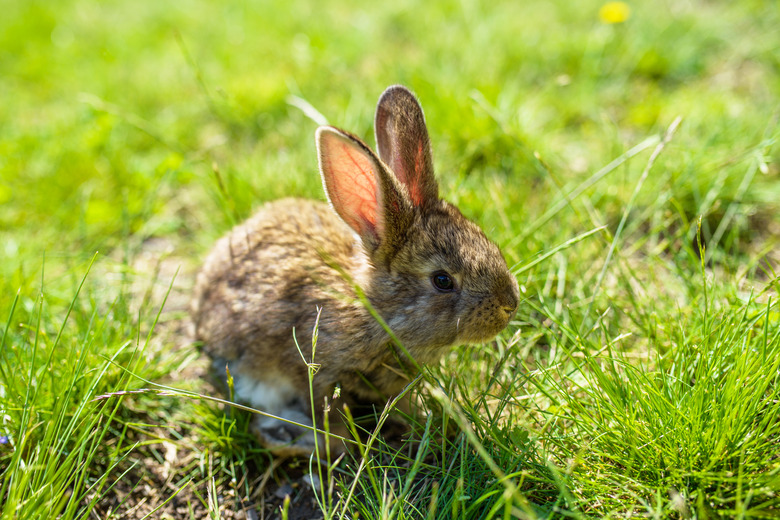How To Nurse Or Care For A Wild Baby Rabbit
If you find wild baby rabbits, don't assume that they've been abandoned. Even if you see a baby rabbit alone, this doesn't mean the mother has left it forever. Mother rabbits tend to feed their babies once or twice per day, so it's normal for you to see them alone sometimes. The mothers will frequently leave the wild baby rabbits in between feedings. However, if you're confident the mother is dead and have determined that baby rabbit care is necessary, then read on to learn about nursing them.
Warning
Wild animals can carry disease. Always handle the baby rabbit with gloved hands.
Step 1
Observe the situation before touching the babies. If the wild baby rabbit is crying most of the day, this is usually a sign that it's abandoned. Well-fed wild baby rabbits usually sleep all day. Also, check the coloring. If the baby rabbit looks pink and plump, his mom is probably around and nursing baby rabbits. Thin, blue-skinned babies may be starving.
Step 2
Prepare a warm nest for the wild baby rabbit. A small cardboard box lined with a soft cotton towel should suffice. You will need to keep the box in an area that has a constant temperature of 65 degrees Fahrenheit or higher. If this is impossible, set a heating pad under the box, set at the required temperature.
Step 3
Slip on a pair of cotton gloves and scoop the baby rabbit out of the nest with your cupped hand, carefully. Place the wild baby rabbit in the box. Gently drape a second towel over the top of the cardboard box, leaving a slight opening for air circulation. A dark environment will mimic his natural nest.
Step 4
Nurse the wild baby rabbit if a veterinarian is unavailable. A liquid kitten mix known as KMR (kitten milk replacer), sold in most pet stores, will provide adequate nutrition. Simply fill an eyedropper with 5 cubic centimeters of KMR if the baby is a newborn (eyes closed), 7- to 13-CC for a 2-week old baby rabbit (eyes slightly open) and 15 CC for a wide-eyed wild baby rabbit. Once the 15-CC dose has been reached, maintain that dosage until the baby is weaned.
Step 5
Gather the wild baby rabbit in his blanket and feed him on his back, just as you would a human baby. Put the dropper to the baby rabbit's mouth and allow him to suck the KMR at his own pace. Most baby rabbits will appreciate feedings twice a day. Once in the early morning and again late at night, just like in the wild.
Step 6
Place the wild baby rabbit back in the cardboard box in between feedings and try not to handle him more than necessary. Check on him regularly throughout the day.
Things Needed
- Small cardboard box
- Soft cotton towels
- Cotton gloves
- KMR (kitten milk replacer)
- Eyedropper
- Timothy grass
TL;DR (Too Long; Didn't Read)
Add some Timothy grass to the wild baby rabbit's cardboard box as a supplement, once his eyes are fully open. Once you notice that he is eating the hay, he is ready to go back out into the wild.
If you notice that the wild baby rabbit is not urinating or passing stool, he may need some assistance. Run your gloved finger gently up and down over his belly, down to his anal area. The stimulation of the massage will help him eliminate.
Warning
Don't feed a wild baby rabbit more than twice per day. Never exceed the 30-CC dose on a single day.
References
Cite This Article
MLA
Fredericks, Jonae. "How To Nurse Or Care For A Wild Baby Rabbit" sciencing.com, https://www.sciencing.com/nurse-care-wild-baby-rabbit-6382537/. 24 April 2018.
APA
Fredericks, Jonae. (2018, April 24). How To Nurse Or Care For A Wild Baby Rabbit. sciencing.com. Retrieved from https://www.sciencing.com/nurse-care-wild-baby-rabbit-6382537/
Chicago
Fredericks, Jonae. How To Nurse Or Care For A Wild Baby Rabbit last modified March 24, 2022. https://www.sciencing.com/nurse-care-wild-baby-rabbit-6382537/
